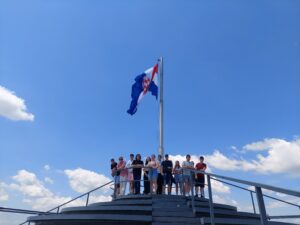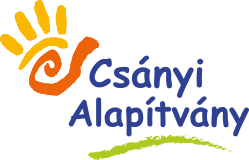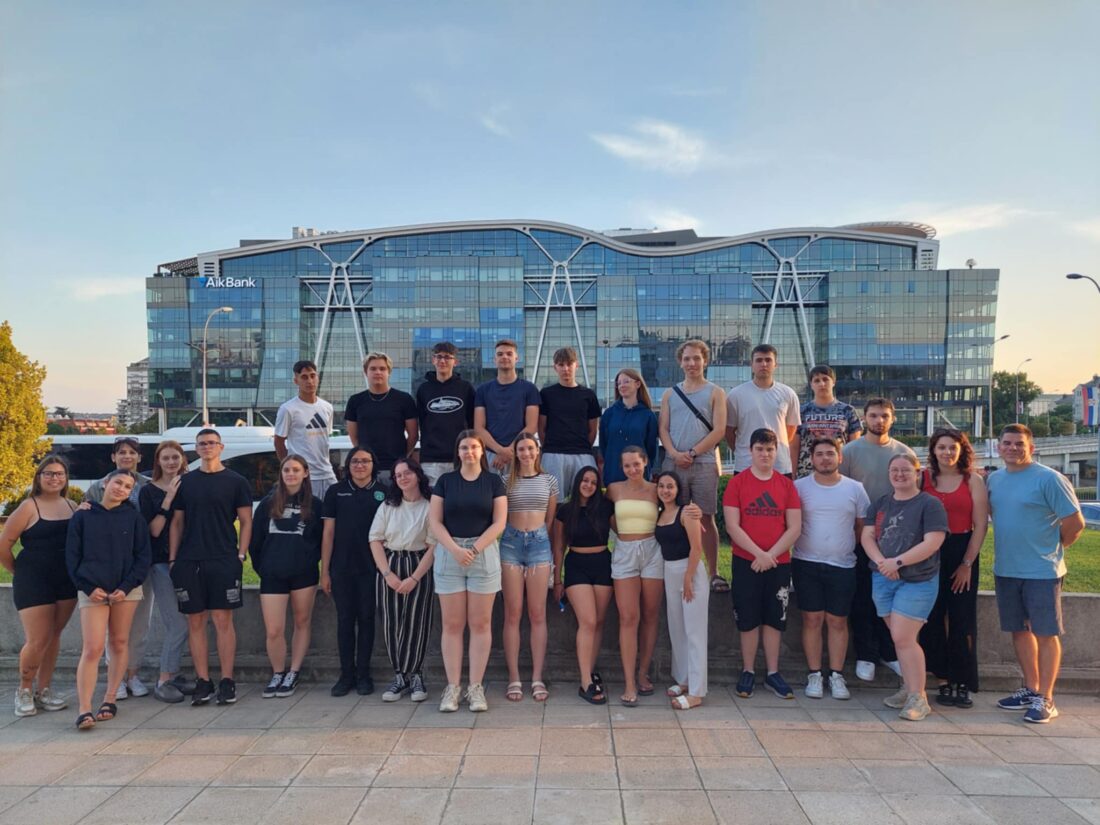
Historical and local history camp in Délvidék
Monday:
“After the great challenge of this year—the final exams—our two groups were finally able to meet again. It was such a joy to see each other after so long. Even during the bus ride, we started sharing what had happened in our lives lately. After recovering from the long journey, we set out on Monday to explore the city. As we headed toward the city center, our tour guide introduced us to the highlights of Belgrade.
Our first stop was the Kalemegdan Fortress, where we learned about its historical significance. Located at the confluence of the Sava and Danube rivers, it is one of Belgrade’s most famous historic sites. Due to its strategic importance, it changed hands many times throughout history, including being held by the Hungarians. Once known as Nándorfehérvár, it was famously defended by Hungarian forces led by Hunyadi against the massive Turkish army of Sultan Mehmed II. This victory not only protected Hungary but also temporarily halted the Ottoman expansion into Europe. In memory of this triumph, the Pope ordered the noon bell to be rung, a tradition that still continues in many places today to honor Hunyadi’s heroism.
Within the fortress, we visited the Ružica Church, which had been destroyed and rebuilt several times throughout history, finally taking its current form in 1925 after damage during the World Wars. One of its unique features is the chandelier room: chandeliers made of artillery shells and swords hang from the ceiling, symbolizing both the horrors of war and the hope for peace.
We then used public transportation to reach our next destination. Along the way, we experienced a bit of everyday city life. Many of us began to reflect on the fact that soon, we too would be living in big cities—if not in Serbia, then elsewhere—where buses and trams will become part of our daily routine.
Eventually, we arrived at the Nikola Tesla Museum. A short film introduced us to Tesla’s life, followed by exciting demonstrations—some of which we could even take part in ourselves. Thanks to the museum’s interactive elements, we gained a lot of new knowledge. After dinner, those with the energy joined an evening walk, where we had the chance to experience Belgrade’s architectural diversity more intimately.”
—Tilda Tamasi, Jászság Group 3
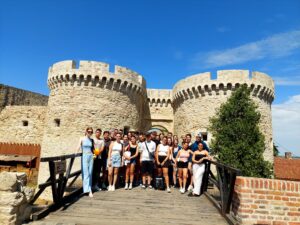
Tuesday:
“On Tuesday, we set off again, this time heading to the Golubac Fortress. Set in a picturesque location on the banks of the Danube, we spent several enjoyable hours exploring the fortress. Golubac’s most famous siege victory is tied to the name of Pál Kinizsi, and throughout the day, we traveled back in time to the 15th century. The exhibition guided us through the battle’s progression and the layout of the fortress, including bastions submerged by the Danube. Our guide told us about the fortress’s history and recent renovations. The modern experience center surrounding the historical site has become increasingly popular with tourists, emphasized by a key phrase from the short film we watched: ‘Every happy ending is the beginning of something new.’
The Golubac Fortress stands at the entrance of the Iron Gates Gorge—the narrowest and deepest part of the Danube in the region. The scenery was simply breathtaking. On our way back, we made a short detour for lunch. We got to taste a local specialty, ćevapi, a popular dish across the Balkans made from spiced minced meat and onions, with a distinctive, mildly smoky flavor. To top off the day, we visited one of Belgrade’s free beaches, where we had the chance to swim, play volleyball, and relax. It was another day full of adventures. Thank you for the experience!”
—Milán Vajda, Nagybajom Group 2

Wednesday:
“The sun had barely risen when we were already on the road. A new day awaited us—not just with new places but new stories. As the bus quietly moved forward, we had a strange feeling: today we wouldn’t just cross cities, but eras.
Our first stop was Novi Sad—Serbia’s second-largest city—which felt strangely familiar. Perhaps it was the Danube, the occasional Hungarian words in the air, or simply the atmosphere of the city, which reminded us of Szeged’s slightly eccentric cousin.
The Petrovaradin Fortress, our destination, wasn’t just a building—it was a living monument. Walking among its massive stones, we had the sense that it was watching us. It’s no surprise that the place is called the ‘Gibraltar of the Danube’—its strategic strongholds and scenic views radiate a power that’s hard to describe. From above, the Danube flowed solemnly yet peacefully beneath us, as if it wanted to tell us stories—but its voice was too deep to understand.
After saying goodbye to Novi Sad, we headed towards Osijek in Croatia. The landscape gradually changed, almost imperceptibly—a new country, a new city, but the same inner silence and curiosity accompanied us. That evening, walking along the Drava River in the last rays of sunlight, we talked—and sometimes just remained silent. We didn’t need a map or guide. We simply walked, and the river carried away the day’s thoughts.
There weren’t many events, but there was presence. A feeling that what we were seeing and experiencing at that moment couldn’t be repeated. It felt like the past wasn’t just in books—but in the reflection of the water, the cracks in the stones, or a whispered sentence on a riverbank walk.”
—Gyula Pege, Jászság Group 3
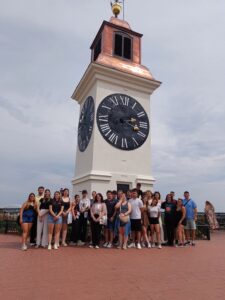
Thursday:
“Unfortunately, today’s morning program had to be moved to the afternoon due to bad weather. The morning rain and gloomy skies didn’t allow for a safe and enjoyable outdoor program. Thankfully, the weather improved in the afternoon, and at 2 PM we visited the beautiful Kopački Rit, one of the most unique and biodiverse wetland habitats in the Danube–Drava National Park. The program began with a short but very informative introduction given by one of the park staff. We learned about the area’s history, ecological significance, and the species living there. Then came the boat trip, where we could admire the fascinating wildlife and serene waterscapes up close. Along the reeds and oxbow lakes, we often spotted egrets, grey herons, and white-tailed eagles. The joyful mood stayed with us the whole time—everyone enjoyed both nature and each other’s company. This shared experience not only offered relaxation but brought us closer together. We hope that next time the weather will be kinder, and we’ll be able to follow our program as originally planned!”
—Orsolya Varga (Jászság Group 3), Anna Horváth (junior mentor, Jászság Group 1)
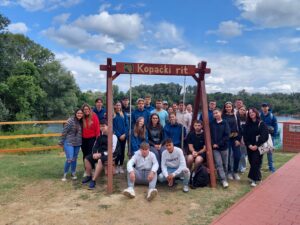
Friday:
“We began our day in Syrmia, 36 kilometers from Osijek. I’ve long wanted to visit this area since my grandparents spent a lot of time here visiting family friends in Vukovar. We started the morning at the Vukovar Memorial Site, where most of us not only saw military vehicles but could also climb into them and experience what it’s like to be inside such machines. We then continued to the water tower, which was both shocking and symbolic—representing the losses and sacrifices of war, as well as the triumph of survival, as we admired the view beside a huge Croatian flag on the rooftop terrace. At the nearby cemetery, we laid a bouquet in memory of those who died during the 87-day siege.
The siege began in August 1991 between the Yugoslav People’s Army and Croatian forces. The cause was the nationalist policies of Slobodan Milošević and Croatian President Franjo Tuđman, which led to the breakup of Yugoslavia and armed uprising of Croatian Serbs, supported by the Serbian government and paramilitary groups. In May 1991, conflict broke out in the East Slavonia region of Croatia. In August, the JNA attacked Croatian-controlled parts of Eastern Slavonia, including Vukovar. The siege officially began on August 25, 1991. It became the most destructive and longest battle in Europe since WWII. Vukovar was the first major European city to be completely destroyed since that war. The water tower, heavily damaged during the siege, became a symbol of the conflict in 2010 and has been preserved in its ruined state. Today, the site functions as a museum.
When the city fell on November 18, 1991, Serbian forces massacred hundreds of soldiers and civilians and deported at least 31,000 civilians from the city and surrounding areas. The war losses are estimated between 4,000 and 5,000 people—Vukovar lost 60% of its population. The city remained part of the Republic of Serbian Krajina until 1995. We ended this eventful day—and the camp itself—at Aquapark Bizovac, where we could swim and cool down in the pools to our hearts’ content.
With full hearts and new knowledge, Groups Nagybajom 2 and Jászság 3 close this adventurous week. We thank our mentors and the Foundation for this wonderful experience!”
—Boglárka Szalai, Nagybajom Group 2
More photos can be found in the Gallery!
